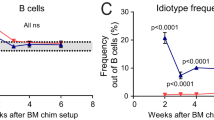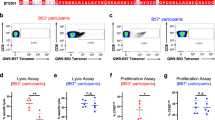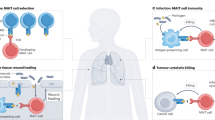Abstract
The rules governing which T cells are inactivated during peptide-induced tolerance are unclear. Here we show that MBP(89–101) contains three overlapping but distinct T cell epitopes that are restricted by a single major histocompatibility complex (MHC) class II molecule. The dominant epitope is not processed from MBP and is not relevant to the induction of autoimmunity. Pathogenic T cells recognize two minor epitopes that are processed from MBP but are presented only poorly after exposure to MBP(89–101). Induction of immunological tolerance by MBP(89–101) therefore inactivates T cells that recognize the dominant epitope and disease-relevant T cells escape tolerance. The topology of the three epitopes implicates asparagine endopeptidase as the enzyme that controls recognition of this region of MBP. Our results highlight the need to use peptides that mimic the binding of processed antigen fragments to MHC molecules for successful modulation of disease-relevant T cells.
This is a preview of subscription content, access via your institution
Access options
Subscribe to this journal
Receive 12 print issues and online access
$209.00 per year
only $17.42 per issue
Buy this article
- Purchase on Springer Link
- Instant access to full article PDF
Prices may be subject to local taxes which are calculated during checkout








Similar content being viewed by others
References
Watts, C. Capture and processing of exogenous antigens for presentation on MHC molecules. Annu. Rev. Immunol. 15, 821–850 (1997).
Sercarz, E. E. et al. Dominance and crypticity of T cell antigenic determinants. Annu. Rev. Immunol. 11, 729–766 (1993).
Sakai, K. et al. Characterization of a major encephalitogenic T cell epitope in SJL/J mice with synthetic oligopeptides of myelin basic protein. J. Neuroimmunol. 19, 21–32 (1988).
Zamvil, S. S. et al. T-cell epitope of the autoantigen myelin basic protein that induces encephalomyelitis. Nature 324, 258–260 (1986).
Chou, Y. K., Vandenbark, A. A., Jones, R. E., Hashim, G. & Offner, H. Selection of encephalitogenic rat T-lymphocyte clones recognizing an immunodominant epitope on myelin basic protein. J. Neurosci. Res. 22, 181–187 (1989).
Kono, D. H. et al. Two minor determinants of myelin basic protein induce experimental allergic encephalomyelitis in SJL/J mice. J. Exp. Med. 168, 213–227 (1988).
Offner, H. et al. T cell determinants of myelin basic protein include a unique encephalitogenic I-E-restricted epitope for Lewis rats. J. Exp. Med. 170, 355–367 (1989).
Tuohy, V. K., Lu, Z., Sobel, R. A., Laursen, R. A. & Lees, M. B. Identification of an encephalitogenic determinant of myelin proteolipid protein for SJL mice. J. Immunol. 142, 1523–1527 (1989).
Martin, R. & McFarland, H. F. Immunological aspects of experimental allergic encephalomyelitis and multiple sclerosis. Crit. Rev. Clin. Lab. Sci. 32, 121–182 (1995).
Wraith, D. C., Smilek, D. E., Mitchell, D. J., Steinman, L. & McDevitt, H. O. Antigen recognition in autoimmune encephalomyelitis and the potential for peptide-mediated immunotherapy. Cell 59, 247–255 (1989).
Metzler, B. & Wraith, D. C. Inhibition of experimental autoimmune encephalomyelitis by inhalation but not oral administration of the encephalitogenic peptide: influence of MHC binding affinity. Int. Immunol. 5, 1159–1165 (1993).
Liu, G. Y. & Wraith, D. C. Affinity for class II MHC determines the extent to which soluble peptides tolerize autoreactive T cells in naive and primed adult mice—implications for autoimmunity. Int. Immunol. 7, 1255–1263 (1995).
Anderton, S. M. & Wraith, D. C. Hierarchy in the ability of T cell epitopes to induce peripheral tolerance to antigens from myelin. Eur. J. Immunol. 28, 1251–1261 (1998).
Karin, N., Mitchell, D. J., Brocke, S., Ling, N. & Steinman, L. Reversal of experimental autoimmune encephalomyelitis by a soluble peptide variant of a myelin basic protein epitope: T cell receptor antagonism and reduction of interferon γ and tumor necrosis factor α production. J. Exp. Med. 180, 2227–2237 (1994).
Brocke, S. et al. Treatment of experimental encephalomyelitis with a peptide analogue of myelin basic protein. Nature 379, 343–346 (1996).
Viner, N. J., Nelson, C. A., Deck, B. & Unanue, E. R. Complexes generated by the binding of free peptides to class II MHC molecules are antigenically diverse compared with those generated by intracellular processing. J. Immunol. 156, 2365–2368 (1996).
Nelson, C. A., Viner, N. J. & Unanue, E. R. Appreciating the complexity of MHC class II peptide binding: lysozyme peptide and I-Ak. Immunol. Rev. 151, 81–105 (1996).
Gaur, A. et al. Amelioration of relapsing experimental autoimmune encephalomyelitis with altered myelin basic protein peptides involves different cellular mechanisms. J. Neuroimmunol. 74, 149–158 (1997).
Wauben, M. H. et al. Inhibition of experimental autoimmune encephalomyelitis by MHC class II binding competitor peptides depends on the relative MHC binding affinity of the disease-inducing peptide. J. Immunol. 152, 4211–4220 (1994).
Franco, A. et al. T cell receptor antagonist peptides are highly effective inhibitors of experimental allergic encephalomyelitis. Eur. J. Immunol. 24, 940–946 (1994).
Anderton, S. M., Kissler, S., Lamont, A. G. & Wraith, D. C. Therapeutic potential of TCR antagonists is determined by their ability to modulate a diverse repertoire of autoreactive T cells. Eur. J. Immunol. 29, 1850–1857 (1999).
Sakai, K. et al. Involvement of distinct murine T-cell receptors in the autoimmune encephalitogenic response to nested epitopes of myelin basic protein. Proc. Natl Acad. Sci. USA 85, 8608–8612 (1988).
Ota, K. et al. T-cell recognition of an immunodominant myelin basic protein epitope in multiple sclerosis. Nature 346, 183–187 (1990).
Martin, R. et al. Fine specificity and HLA restriction of myelin basic protein-specific cytotoxic T cell lines from multiple sclerosis patients and healthy individuals. J. Immunol. 145, 540–548 (1990).
Valli, A. et al. Binding of myelin basic protein peptides to human histocompatibility leukocyte antigen class-II molecules and their recognition by T cells from multiple sclerosis patients. J. Clin. Invest. 91, 616–628 (1993).
Madsen, L. S. et al. A humanized model for multiple sclerosis using HLA-DR2 and a human T cell receptor. Nature Genet. 23, 343–347 (1999).
Bielekova, B. et al. Encephalitogenic potential of the myelin basic protein peptide (amino acids 83–99) in multiple sclerosis: results of a phase II clinical trial with an altered peptide ligand. Nature Med. 6, 1167–1175 (2000).
Kappos L. et al. Induction of a non-encephalitogenic type 2 helper T cell autoimmune response in multiple sclerosis after administration of an altered peptide ligand in a placebo-controlled, randomised phase II trial. Nature Med. 6, 1176–1182 (2000).
Bodmer, H., Viville, S., Benoist, C. & Mathis, D. Diversity of endogenous epitopes bound to MHC class II molecules limited by invariant chain. Science 263, 1284–1286 (1994).
Inaba, K. et al. The tissue distribution of the B7-2 costimulator in mice: abundant expression on dendritic cells in situ and during maturation in vitro. J. Exp. Med. 180, 1849–1860 (1994).
Vremec, D. & Shortman, K. Dendritic cell subtypes in mouse lymphoid organs: cross-correlation of surface markers, changes with incubation, and differences among thymus, spleen, and lymph nodes. J. Immunol. 159, 565–573 (1997).
Summers, K. L., Hock, B. D., McKenzie, J. L. & Hart, D. N. Phenotypic characterization of five dendritic cell subsets in human tonsils. Am. J. Pathol. 159, 285–295 (2001).
Matzinger, P. Tolerance, danger, and the extended family. Annu. Rev. Immunol. 12, 991–1045 (1994).
Metzler, B., Anderton, S. M., Manickasingham, S. P. & Wraith, D. C. Kinetics of peptide uptake and tissue distribution following a single intranasal dose of peptide. Immunol. Invest. 29, 61–70 (2000).
Moudgil, K. D., Sercarz, E. E. & Grewal, I. S. Modulation of the immunogenicity of antigenic determinants by their flanking residues. Immunol. Today 19, 217–220 (1998).
Anderton, S. M., van der Zee, R., Prakken, B., Noordzij, A. & van Eden, W. Activation of T cells recognizing self 60-kD heat shock protein can protect against experimental arthritis. J. Exp. Med. 181, 943–952 (1995).
Fairchild, P. J., Pope, H. & Wraith, D. C. The nature of cryptic epitopes within the self-antigen myelin basic protein. Int. Immunol. 8, 1035–1043 (1996).
Yu, M., Johnson, J. M. & Tuohy, V. K. A preditable sequential determinant spreading cascade invariably accompanies progression of experimental autoimmune encephalomyelitis: a basis for peptide-specific therapy after onset of clinical disease. J. Exp. Med. 183, 1777–1788 (1996).
Cross, A. H., Hashim, G. A. & Raine, C. S. Adoptive transfer of experimental allergic encephalomyelitis and localization of the encephalitogenic epitope in the SWR mouse. J. Neuroimmunol. 31, 59–66 (1991).
Manoury, B. et al. An asparaginyl endopeptidase processes a microbial antigen for class II MHC presentation. Nature 396, 695–699 (1998).
Antoniou, A. N., Blackwood, S. L., Mazzeo, D. & Watts, C. Control of antigen presentation by a single protease cleavage site. Immunity 12, 391–398 (2000).
Manoury, B. et al. Destructive processing by asparagine endopeptidase limits presentation of a dominant T cell epitope in myelin basic protein. Nature Immunol. 3 10.1038/ni754 (2002).
Hemmer, B. et al. Human T-cell response to myelin basic protein peptide (83–99): extensive heterogeneity in antigen recognition, function, and phenotype. Neurology 49, 1116–1126 (1997).
Martin, R. et al. Diversity in fine specificity and T cell receptor usage of the human CD4+ cytotoxic T cell response specific for the immunodominant myelin basic protein peptide 87–106. J. Immunol. 148, 1359–1366 (1992).
Jones, P. P., Murphy, D. B. & McDevitt, H. O. Variable synthesis and expression of Eα and Ae (Eβ) Ia polypeptide chains in mice of different H-2 haplotypes. Immunogenetics 12, 321–337 (1981).
Mathis, D. J., Benoist, C., Williams, V. E., Kanter, M. & McDevitt, H. O. Several mechanisms can account for defective Eα gene expression in different mouse haplotypes. Proc. Natl Acad. Sci. USA 80, 273–277 (1983).
Bates, I. R. et al. Characterization of a recombinant murine 18.5-kDa myelin basic protein. Protein Expres. Purif. 20, 285–299 (2000).
Anderton, S. M. et al. Fine specificity of the myelin-reactive T cell repertoire: implications for TCR antagonism in autoimmunity. J. Immunol. 161, 3357–3364 (1998).
Acknowledgements
This work was supported by grants from the Wellcome Trust and the Medical Research Council (MRC). S. M. A. is an MRC research fellow.
Author information
Authors and Affiliations
Corresponding author
Ethics declarations
Competing interests
The authors declare no competing financial interests.
Rights and permissions
About this article
Cite this article
Anderton, S., Viner, N., Matharu, P. et al. Influence of a dominant cryptic epitope on autoimmune T cell tolerance. Nat Immunol 3, 175–181 (2002). https://doi.org/10.1038/ni756
Received:
Accepted:
Published:
Issue Date:
DOI: https://doi.org/10.1038/ni756
This article is cited by
-
Non-mutational neoantigens in disease
Nature Immunology (2024)
-
2021 update on thyroid-associated ophthalmopathy
Journal of Endocrinological Investigation (2022)
-
Clinical and immunological control of experimental autoimmune encephalomyelitis by tolerogenic dendritic cells loaded with MOG-encoding mRNA
Journal of Neuroinflammation (2019)
-
ATX-MS-1467 Induces Long-Term Tolerance to Myelin Basic Protein in (DR2 × Ob1)F1 Mice by Induction of IL-10-Secreting iTregs
Neurology and Therapy (2018)
-
Selection of epitopes from self-antigens for eliciting Th2 or Th1 activity in the treatment of autoimmune disease or cancer
Seminars in Immunopathology (2017)



